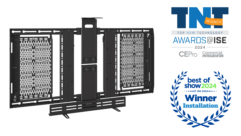
Presidential Library Showcases AV
The William J. Clinton Presidential Center is the nation’s newest presidential library. Using a wealth of AV technologies, including large-format projected imagery, interactive computer-based exhibits, and LCD video displays, the facility features an 80-seat orientation theater, full-size replicas of the Oval Office and Cabinet Room, a 110-foot timeline, and other exhibits that visually depict various milestones in the Clinton Presidency.
Each section of the 110-foot timeline has a 20-inch LCD monitor showing a video clip related to that year of Clinton’s presidency.
CHALLENGE: Upgrade VHS-quality presidential video archives for use with high-definition systems.
SOLUTION: Install multiple frame-synchronized and edge-blended display technologies with pixel-matched footage to create a high-quality presentation.
Debuting to a crowd of approximately 30,000 in Little Rock, AK, on Nov. 18, 2004, the William J. Clinton Presidential Center is the nation’s newest presidential library. Using a wealth of AV technologies, including large-format projected imagery, interactive computer-based exhibits, and LCD video displays, the facility features an 80-seat orientation theater, full-size replicas of the Oval Office and Cabinet Room, a 110-foot timeline, and other exhibits that visually depict various milestones in the Clinton Presidency.
Working from a blueprint authored by New York-based consultants Cerami & Associates and exhibits designed by Ralph Appelbaum Associates of New York, Electrosonic, a Minneapolis-based integrator was chosen to handle the installation of the facility’s nearly $1.5 million worth of AV technologies. Electrosonic was challenged by an extremely short installation deadline — with work commencing on Sept. 9, 2004, and doors opening to the public barely 10 weeks later.
Although construction of the facilities had been under way for quite some time, the Electrosonic team, headed by Site Supervisor Randy Smith from the company’s Orlando, FL-based office, found barren walls, concrete floors, and little else upon its arrival. “We were working under an extremely tight schedule,” says LeRoy Weibel, Electrosonic’s senior project manager/project engineer. “The cable pullers and exhibit builders were barely one step ahead of us. It’s no exaggeration to say that the moment an exhibit wall was nailed into place, we were hanging something from it. While the Library opened in mid November, we remained onsite and actually completed the installation in early December.”
The Clinton Library’s core technologies are video and audio used to depict stories at the multiple display stations positioned throughout the facility. There are also videoconferencing facilities, which are not available to the public. While there are multiple exhibit areas, the Library serves as the focal point housing the majority of the exhibits.
AV infrastructure
Throughout the Library, the only equipment physically residing in the actual exhibits are the video monitors, loudspeakers, and user interfaces. All source equipment, including the computers used for 18 interactive displays, is housed in a central control room. Video and computer images, plus control-signal distribution to the exhibits is transmitted over Cat5 UTP cable.
FROM VHS TO HD BIG SCREEN
The Clinton Library’s Cabinet Room presentation of Clinton’s first inauguration ceremony (1993) was captured in what could best be described as VHS-quality footage. Intended to be one of the key exhibits at the Library, the goal was to project this content onto a surface measuring 21 feet by 7 feet that was in close proximity to the audience. The initial design called for standard-definition video players, edge blended through an outboard system, and then projected onto the screen. However, both Minneapolis-based AV integrator Electrosonic and Donna Lawrence Productions of Louisville, KY, (producers of the presentation) recognized that the quality of the source material would be problematic.
“We convinced the client we needed high-definition players for this task — particularly because of the quality of the source material,” says Tony Petruzziello, senior systems consultant for Electrosonic. “Without HD, the presentation would have been extremely grainy.”
This picture enhancement added pixels to “simulate” a high-definition picture — hence upgrading the image. Without the enhanced pixel count (which “fills in” the holes in an otherwise low-resolution picture), the image would have appeared very grainy when displayed at such a large size. By using three edge-blended MS9200P HD video servers to create a composite image, overall image quality was enhanced significantly.
Working in the digital domain, the Donna Lawrence team created a picture canvas that has as many pixels as three projectors edge blended together (roughly 2,800 pixels wide). The image was then divided into three high-definition streams totaling the pixel count. The three HD video streams are then fed from three Electrosonic Media Networks MS9200P HD video servers to three Christie LX37 3,700-lumen, XGA projectors and edge blended together using the MS9200’s internal edge-blending circuitry. The 21- by 7-foot projection surface was created with Goo Systems’ Screen Goo Digital Grey basecoat and topcoat.
“By taking this approach with the original material and using players that have edge-blending capability, Donna Lawrence and Electrosonic were able to eliminate a considerable amount of outboard signal processing that would have, in all likelihood, added additional artifacts,” Petruzziello says. “We managed to take the source material from what would have resulted in an incredibly mediocre projected image to one that is really quite good.”
Because each of the individual exhibits incorporates displays, loudspeakers, and interactive user interfaces, signal routing between the exhibits and the central control room housing the computers and servers is extensive. Audio and video signal routing tasks are handled by a variety of Extron matrix switchers, including the CrossPoint 42HVA matrix switcher (a 4×2 analog RGBHV matrix switcher for switching RGBHV signals and two-channel stereo audio) as well as CrossPoint 84HVA 8×4 ultra-wideband, analog RGBHV models. S-video signals are routed by MAV 84 SV switchers. Extron SW4 RGBHV four-input switchers are also employed, along with 40 Extron Cat5/S-video converters (MTP R SV receivers and MTP T SV transmitters), which are used to handle the conversion from Cat5 video to S-video for connection to the display monitors.
Four MediaMatrix X-Frame 88 audio digital signal processors, used in conjunction with three MediaMatrix MM-8802 DSP I/O expanders, manage equalization and related audio processing tasks. From the MediaMatrix, audio signals are routed to IRP Professional Sound Products’ PA-450 Series four-channel power amplifiers prior to reaching the TOA Electronics’ H-1 model loudspeakers used in the displays.
Overall exhibit control — the programming of video sequences, scheduling of operation, and system monitoring — is managed by an AMX NetLinx system. Key AMX components include NI-2000 and NI-3000 control system processors plus AXT-CA10 and AXT-CG10 touchpanel controllers. The AMX system is accessible only by Library AV staffers for system management.
Big-screen inauguration presentation
The Cabinet Room exhibit features a simulated high-definition, large-screen presentation of Clinton’s first inauguration ceremony. Working from VHS-quality footage supplied by the National Archive and Records Administration (NARA), this exhibit presented the project’s greatest challenge, as the source material was (by today’s standards) relatively low quality — yet needed to be displayed on a surface measuring 21 feet by 7 feet (see sidebar at right). Compounding this challenge, visitors were to stand very close to the projected image.
Three Electrosonic Media Networks MS9200P HD video servers, each with edge-blending capabilities, handle the mixed video and graphics sources, which feed three Christie LX37 3,700-lumen, XGA projectors. Operating in precise frame synchronization, the three players create the composite image. “It’s vivid and remarkably detailed given the nature of the source content,” says Tony Petruzziello, senior systems consultant for Electrosonic.
Library exhibits
The main Library exhibit area consists of a series of display “alcoves” that show archival material from the Clinton Presidency. NEC LCD3000 (30-inch) and LCD4000 (40-inch) LCD displays are used throughout. The majority of video playback is fed via 10 Electrosonic Media Networks MS9304 SD video servers to the 30-inch NEC displays. Each server can output four channels of video, and each channel (within an individual server) is assigned to a particular exhibit. The MS9304 video servers also provide content to a number of Vartech Systems VT201C 20-inch LCD panels positioned along the exhibit’s timeline with additional placements on the Library’s third floor.
The 40-inch NEC monitors in the alcoves are fed via Electrosonic Media Networks MS9400 single-channel HD video players. In a similar fashion to the upgraded images used in the Cabinet Room presentation — where much of the original video footage was VHS-quality — several of these exhibits required enhancement of their program material’s pixel count to create a simulated HD environment for better overall picture quality. The HD systems use Magenta Research MultiView 450 Series RGBHV-to-Cat5 receiver/transmitter systems to handle the conversion between Cat5 signal and the RGBHV signals that feed the displays.
While some alcoves have as many as three displays, audio only plays for one display at a time. The material is designed to switch audio segments automatically. Cortina Productions of McLean, VA, produced the content for the alcoves and the timeline.
In addition to the challenge of creating simulated HD imagery for the projected presentation in the Cabinet Room as well as the 40-inch LCD displays, audio crosstalk between adjacent alcoves and the timeline exhibit also required special attention. Depicting world events from 1993 to 2000 (the years of the Clinton Presidency), the timeline is a dual-sided exhibit area consisting of eight Vartech Systems VT201C 20-inch LCD panels on one side and another eight Vartech Systems VT188CC-CT touchscreen displays, used in conjunction with eight Dell Optiplex SX270 computers, running down the other side. The fixed exhibits are outfitted with TOA H-1 model loudspeakers, while the interactive computer-based exhibits are outfitted with Intervox S15X25VA raw-frame loudspeakers from International Components.
FOR MORE INFORMATION
- AMXwww.amx.com
- Christiewww.christiedigital.com
- Dell Computerwww.dell.com
- Electrosonic Media Networkswww.electrosonicmedianetworks.com
- Extron Electronicswww.extron.com
- Goo Systemswww.goosystems.com
- International Componentswww.icc107.com
- IRP Professional Sound Productswww.irp.net
- Magenta Researchwww.magenta-research.com
- MediaMatrixhttp://mediamatrix.peavey.com
- NEC Display Solutionswww.necdisplay.com
- TOA Electronicswww.toaelectronics.com
- Vartech Systemswww.vartechsystems.com
With the alcoves spanning the perimeter of the Library and the timeline running down the middle, audio is everywhere. “Crosstalk audio existed not only between adjacent alcoves, but also from behind the timeline,” Weibel says. “You could be standing in an alcove, and directly behind you (approximately 15 feet) is another monitor with another loudspeaker. Some speakers are positioned above the monitor while others are below. Adjusting the audio levels so that you can hear the audio while watching a video monitor without bleed from adjacent exhibits was a big job. It required careful attention to loudspeaker positioning, level adjustment, and placement of exhibit materials in order to adequately isolate one area from the next. The MediaMatrix X-Frame 88 DSP system played a critical role in helping us address these issues since it was able to perform audio routing, equalization, and level adjustment tasks in a single system.”
Further isolation was accommodated by the very design of the actual exhibit walls and the “alcoves” those walls created.
An unforgettable experience
Through the efforts of the William J. Clinton Foundation, the Clinton Presidential Center’s visitors have the opportunity to gain an in-depth perspective of the Clinton Presidency and the issues that confronted the country during his two terms in office. “The Clinton Presidential Center was undoubtedly the most prestigious job I’ve ever had the pleasure to be a part of,” Weibel says. “It was truly an honor.”
Roger Maycock is the owner of MountainCrest Communications in Downey, CA. A recognized music and sound authority, Maycock has written hundreds of technical articles for a number of trade and consumer publications. He can be reached at [email protected].










